Unfortunately I haven’t been able to update this blog too much over the past year, but I wanted to share a few of the things I’ve been working on. I wish I had more time for blogging, but there has been no rest for the wicked (bookbinder), as I’ve been teaching or doing private work nonstop. I’d like to use this space to catch up a bit with some of the exciting projects I’ve been very lucky to have worked on over the past year. I hope my sharing something about them will make others feel inspired.
Custom box for memorial cards
One of my dearest repeat clients, a photographer who specializes in family portraits, came into my studio one day with a small paper bag filled with remembrance cards, other mementos, and a beautiful glass framed portrait that all needed to go into a box for a local family. This was a challenging project, since all the items were of widely varying sizes and shapes. I made a drop spine box with two separate compartments, a four-flap, and created a new frame out of contrasting book cloth for the portrait.

I created two side-by-side compartments to house most of the cards and letters. They were in honor of a woman who had a deep connection to the area’s redwood forests, so I felt a bit of a connection to her, too.

This is how the inside of the box would be viewed when opened.

This was the front of the box, with the woman’s name stamped in gold.
Working large
Last year I ended up doing a series of three oversize repairs for completely unrelated clients. At the outset, the complexity and challenging nature of each one seemed overwhelming, not to mention three at once. Here are some anecdotal photos of them, with brief explanations, though I might like to post an entire entry at some point, just on these projects.
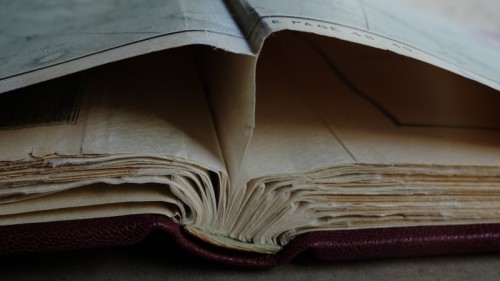
This was an illustrated atlas of Alameda County from the 1800s. There were foldouts, text folios, single sheets and even a few double foldouts. The inside of each foldout had a map, and the outer sides of the map had charming illustrations depicting farms or other points of interest in the area of that map. Each page was a slightly different width, calling for the complicated series of stubs, hinges, and guards you see in this detail photo.
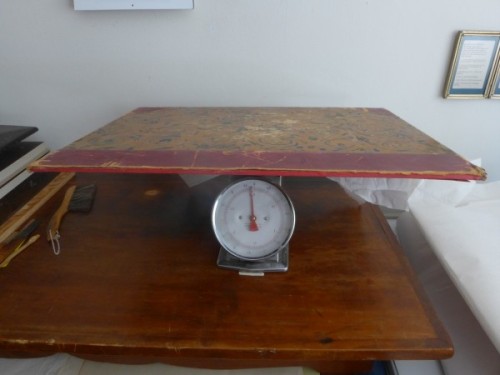
This picture shows the mind-bending immensity of the largest book I have ever repaired (one cover board of it, anyway). I weighed the cover and a single board alone weighed over 6.5 pounds. The main challenge in repairing this particular book was to handle it throughout the repair process with the care it needed in spite of its heft. Good thing I exercise!

This was the initial state of the third of these large books I repaired. All three books also presented challenges simply in the documentation I do for my internal record keeping. I had to move the camera so far away that I couldn’t get very clear photos at times. I took a lot of detail shots to fill in the gaps.

This is the previous book after treatment. Two of the three books required a technique known as a leather reback; the Atlas got a brand new set of covers, since its original covers were severely water damaged.
Prelinger Treasure
Some of the first book conservation I did after moving out to the bay area was for the Prelinger Library, and last year, I was able to do some more work for this innovative collection. They house certain volumes of government publications discarded by other libraries for lack of space, and have happened on some interesting books. One of these that happened into my studio for a time was a record of a US military expedition from Missouri to San Diego conducted in 1841, passing through and reporting heavily on the region now known as New Mexico and Arizona. A researcher at the Prelinger felt the book was important enough to donate the funds to have it repaired, and so I did my best.
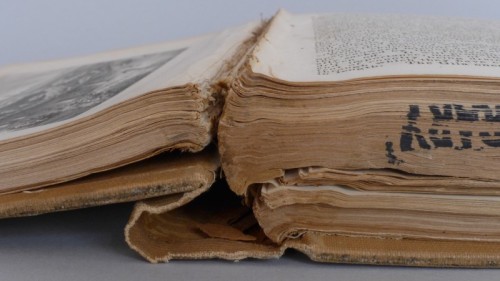
This was the initial condition of this book, with ragged folds at the spine, broken sewing in several places, an odd section of stubs with no pages deforming the rest of the textblock, and many tipped-in illustrations in various stages of attachment.

I carefully took apart the entire textblock page by page, then applied paper made from kozo fibers with wheat paste to give the folios a stable footing to be resewn and rebound. Note that only about two thirds of the signatures are in this photo-there were over 40 that all needed extensive guarding.
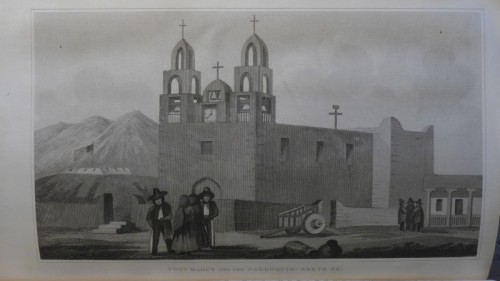
Typical illustration from the text, one of many. Old Santa Fe. If you think the illustration is interesting, you should read the text! For a military report, it is a real page turner, filled with encounters with Native Americans of several different tribes as well as investigations of plants, geological formations, and animals that were completely foreign to the group of topographical engineers authoring the report. This book is available to see, read, and handle at the Prelinger Library. No academic credentials required.
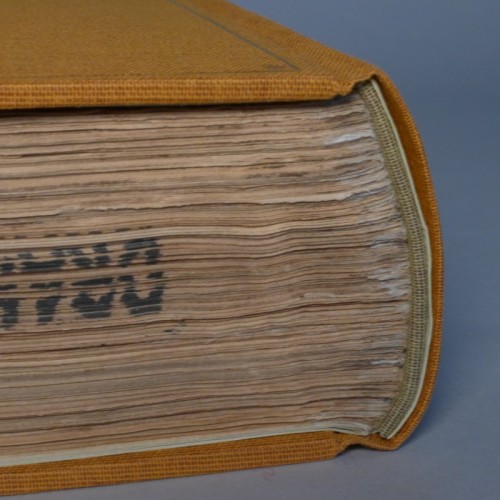
This is the spine after treatment.

This is the cover after treatment.
New bookbinding class at SFCB
I have been teaching classes in bookbinding at the San Francisco Center for the Book since 2011, and have most often focused on offering a foundational series of classes to give students a slice of what I got at the North Bennet Street School. I don’t see any use in hoarding what I know. I have met so many fascinating people while teaching, some becoming clients, friends, or both! So last year, I decided I wanted to push things a step further and offer an additional advanced class in leatherwork for bookbinding. This would be an idealized (for me anyway), traditional style of binding in many ways, though the class would be limited to two or three days of in-class time, depending on which option the Board of the SFCB voted to approve. Lucky for me, they approved the longer three-day version, and the class was held two weekends ago, over the holiday weekend to allow those who travel from long distances to take the class in three successive days.

This binding included lining the boards, sewing on four raised cords, using loose guards, ploughing, sprinking the edges, sewing silk endbands, lacing the boards through twice, and of course covering the spine in specially-pared leather. We also did some blind tooling around the raised bands for a traditional look.
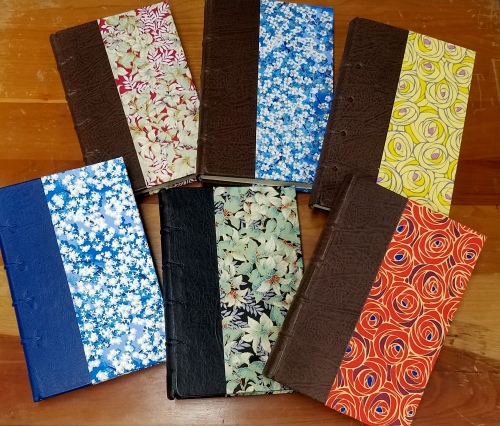
These were all of our books at the end of the class! Everyone survived, and I think we all had a good time, too.
Life has been full; I look forward to more fun on Book Island!
